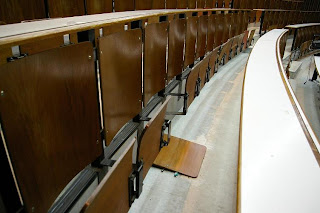Post-module thoughts...
Overall I think this module is on the right track. I find the approaches that we took since early in this module very helpful in trying to set up some kind of a framework to help designers evoke the desired emotions out of whatever product they are designing. The theories on design models such as emotional probes and Jordan’s four pleasure analyses really served as useful framework on user behavior, and the early assignments served as a good exercise to think about some of the ways in which values and pleasure were perceived. For one it actually helped me understand, as a user, on why certain design appeals to me or what kind of values I am deriving out of any particular product. Still, I felt that these frameworks rely very much our interpretation of what our target user would be like, and therefore vulnerable to overgeneralization and misinterpretation. Particularly on the four analysis assignment, I found it hard to design a product benefit specifications based on purely the need analysis without taking into consideration other factors such as taste, aesthetics preference etc.
The ethnographical approach also was a bit limiting in terms of how we could derive useful design ideas, because first of all, all the bits of pieces of information coming from all over the place are hard to quantify, and secondly, we’re making too many assumptions about the conditions in which people operate certain activities. For instance, in our improving learning experience for lecture theatres, it was difficult to gauge what really makes up a good learning experience and whether the technology (in this case, the Lecture theatres) was a great factor which determines that experience.
Some of the lessons from marketing and branding that were covered also helped us understand how they influence the user’s perception of products. Although, I feel that in practice, when it comes to designing products, it is very hard to take into consideration things such as branding because again, branding is a value system which is based on what the stakeholders (or what Christopher Fahey’s article mentioned as the ‘bosses’,) say what it is, which makes it hard to try to map it to what the user might perceive about the product concerned.
For our final project, we sort of tried to put some of the theories and frameworks into practice when we’re designing the product specifications, and I think we managed to get quite a round up specifications based on our user research. We didn’t realize how big of a project our product ended up to be, therefore although the tools that we employed during the iterative design process such as the card sorting, information architecture and prototyping were very helpful to put things into perspective, at the end, because of the limited time, we really didn’t have the chance to properly iterate the design process and we kind of closed off incoming design ideas due to the feature creep that we experienced out of the feedback from all the usability testing that we conducted. In fact I would say towards the end, the focus kind of shift into getting the usability right and kind of neglecting the other emotional user experience part of it. I guess this is how it is in the real world, but perhaps in the future, the final project should be initiated earlier so that students have time to reiterate the design process while still leave some time to think about the greater issue of user experience.
I think this module is tacking one of the most difficult issues out there, which is trying to define what experience is, and how to design it. The issue is that we’re not dealing with hard sciences where everything is measurable, but rather something more subjective and unquantifiable such as pleasure and other emotions. But overall, this module provided me with very good groundings and exposure over the issues of UX while giving me opportunity to experience the challenging process of designing UX.






